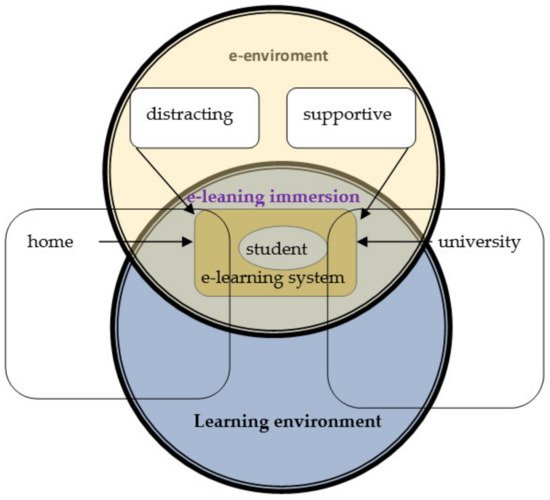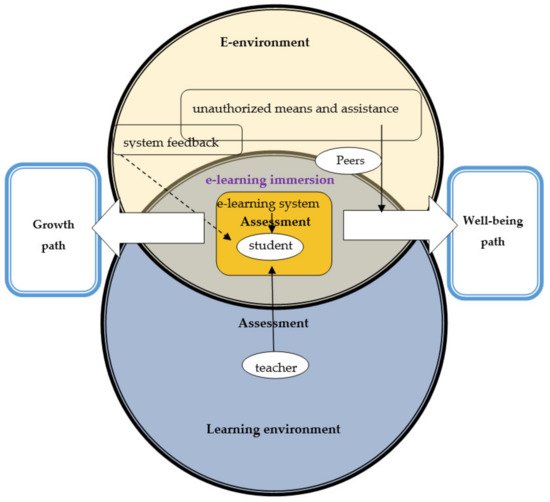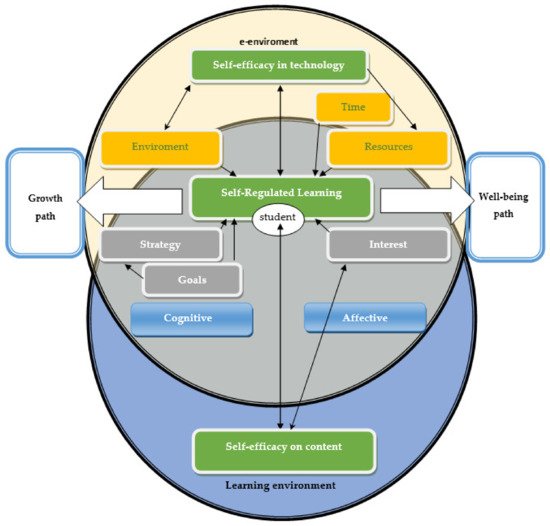The COVID-19 pandemic has contributed to the accelerated spread of e-learning around the world. In e-learning, self-regulation becomes more relevant than ever. Reducing the influence of traditional features of the face-to-face learning environment and increasing the impact of the e-environment place high demands on students’ self-regulation. The author’s self-regulation e-learning model emphasizes the position of e-learning at the intersection of the electronic environment and the learning environment.
1. Introduction
The COVID-19 pandemic has accelerated the existing trends of increasing the share of e-learning in education worldwide. First of all, the problem of technological support for fully online education has grown [
1]. Students and teachers need fast and stable networks, online communication tools, and digital educational resources [
2,
3,
4]. After solving the problems of creating, communicating, and providing technical support for e-courses, it became necessary to take into account the level of technical competence, the psychological aspects of online learning [
5,
6,
7], and the peculiarities of learning in an electronic environment to the extent that fully e-education can completely replace conventional one [
8].
At the same time, the discussion of the advantages and problems of e-learning in higher education for students has a long history. The most obvious comparison of grades between online and face-to-face learning does not show a significant difference [
9,
10,
11,
12], even sometimes there are better grades in the online environment [
13]. Since different factors can influence grades, they cannot serve as a reliable basis for the comparison.
Among the factors that cause a cautious attitude to online learning, one of the most important is that the completion rates are about 8–20% lower than in traditional full-time courses [
14,
15,
16,
17,
18]. The widely observed higher rates in favor of retention for face-to-face learning compared to online learning could be caused by the features of online learning itself or by characteristics of the students who sign up for online courses themselves [
19,
20]. In addition, higher rates of attrition are observed in online courses [
21,
22]. One of the main problems is students’ perception of isolation and lack of communication [
16,
23]. Online courses “can appear to be an impersonal exercise, which leads students to feel ‘eSolated’ from instructional staff” [
24,
25].
Thus, the quality of interaction between teachers and students is considered as one of the most important factors [
26,
27,
28], which is associated with the involvement of students in their educational activities [
29,
30].
Researchers reveal different forms of engagement such as affective, behavioral, and cognitive [
31,
32]. In addition, it would be possible to take into account the academic participation, which refers to academic identification (for example, communication with teachers) and participation in learning (for example, time to complete tasks, rather than skipping classes) [
33].
The lack of direct communication between students, teachers, and peers requires special characteristics. Online students should have so-called “self-traits”, that are connected with:
-Self-determination (competency, autonomy, and relatedness) [34,35];
-Self-regulation [36,37,38,39] that associated with planning, management, and control of the learning process [40];
-Self-discipline [26];
-Self-efficacy [41,42,43,44] that is associated with self-directed behavior and autonomy [45] or students’ confidence in their abilities to successfully fulfill educational requirements [46];
-Emotional intelligence [47].
In addition, students must be familiar with information and communication technologies and satisfied with the program [
48,
49,
50].
One of the main advantages of online learning is flexibility [
51] but this requires good time management skills [
52]. Rochester and Pradel found out that online students appreciate the flexibility in the course and convenient access to various types of educational materials, but they report some problems with understanding the course content [
53].
Self-regulation is currently considered one of the factors associated with the educational process. At the same time, the widespread use of e-learning highlights the problem of self-regulation. It requires a new approach that takes into account the specifics of the digital environment.
2. Self-Regulated Learning Model
Self-regulation is a core aspect of human functioning that helps facilitate the successful pursuit of personal goals [
54], at the same time there is no simple and straightforward understanding of this multidimensional concept [
55]. Historically, self-regulation in education was viewed from cognitive-behavioral [
56] and cognitive-development perspectives [
57]. Social cognitive researchers paid attention to social and motivational factors [
58]. Self-regulation was viewed through the prism of metacognition [
59,
60]. Nowadays, the theory of self-regulation combines cognitive, motivational, social, and behavioral factors taking into account the cultural organizational, and contextual variables [
61].
Zimmerman described self-regulation as the degree to which students “are metacognitively, motivationally, and behaviorally active participants in their own learning process” [
62,
63]. Self-regulation is a mode of volition in which learners form goals following their needs and preferences (self-determination) and flexibly resolving action-related conflicts oriented at self-maintenance [
64]. Students use various cognitive, metacognitive, and self-regulating learning and resource management strategies as part of their learning behavior [
65]. Self-regulated learning is flexible and adaptable, students tend to construct their own repertoire of strategies [
66]. Pintrich notes that students actively create their meanings, goals, and strategies based on information available in the external environment, as well as in their minds [
67].
Researchers reveal personal, environmental, and behavioral determinants of self-regulated learning [
68]. Triadic model associates behavior with personal and environmental factors. Strategy use is shown as follows: from Person to Behavior and further to Environment. Feedback comes to Person from Behavior and Environment. In addition, it unites covert self-regulation, behavioural self-regulation, and environmental self-regulation. [
62,
69]. So self-regulation will be the degree of self-influence on the immediate learning environment and behavior [
70]. It includes self-generated thoughts, feelings, and actions to achieve one’s learning goals [
71].
In the next stage, motivational factors were added to the model, and above all self-efficacy. Zimmerman and Moylan [
70] demonstrate a dynamic cyclical model of self-regulation. It includes the performance phase with self-control and self-observation; the self-reflection phase with self-judgment and self-reaction; and the forethought phase with task analysis and self-motivation beliefs. And self-motivation beliefs include self-efficacy, outcome expectations, task interest/value, and goal orientation [
70].
Self-efficacy is often considered as the main factor that affects self-regulated learning. According to psychologist Albert Bandura, who originally proposed the concept, self-efficacy is a person’s belief in own capability to successfully perform specified tasks [
58]. Zimmerman and Moyla point out that self-efficacy is a source of motivation that precedes efforts to learn and affects students’ preparation and their willingness to self-regulate their learning [
70]. The empirical research show that self-efficacy is directly associated with self-regulated learning strategies [
72,
73], and both self-efficacy and self-regulated learning strategies contributed to the prediction of students’ proficiency [
74,
75,
76].
Pintrich developed four phases-model of self-regulation. The phases are forethought, planning, and activation; monitoring; control; and reaction and reflection. Each of them has four different areas for regulation: cognition, motivation/affect, behavior, and context. The author gives a conceptualization of the goals of academic achievements that students can accept in a classroom environment and their role in constraining self-regulated learning [
67].
Boekaerts’s self-regulation model divides the process into two parts: mastering students’ skills and well-being between which students could switch. The ability to prioritize goals and overcome obstacles determines the choosing path. This model connects students’ perceptions of the environment and different strategies of self-regulation. The model combines task-in-context, (meta) cognitive strategy use, and motivational beliefs, taking into account such factors as appraisal, assessment, affect, and learning intention [
77]. Boekaerts and Rozendaal emphasize that learning environment influences cognition and feelings (self-efficacy, value, etc.) [
78].
Most modern researchers do not single out self-regulation as an autonomous multicomponent phenomenon, but consider it among other factors affecting academic performance. For example, Sadi and Uyar offer the model that connects self-efficacy (SELF), rehearsal (REH), elaboration (ELAB), organization (ORG) and critical thinking strategies (CRITIC), metacognitive self-regulated learning strategies (MSR), time/study environmental management (TSEM), and effort regulation (EFFORT) with learning achievements (ACH) [
72].
The structural model explains the relationship between self-efficacy in learning and academic performance, self-regulated learning strategies, and achievements of high school students. The results of the study show that factors such as metacognitive self-regulating learning strategies, self-efficacy in learning and productivity, organizational strategies, time/study management and effort regulation have a significant positive impact on academic success [
72].
3. Self-Regulated Learning Models in E-Learning
E-learning means a special educational environment. The lack of presence of teachers and peers reduces the impact of social interaction. The existing social influence is carried out through communication mediated by technical means. At the same time, the student is in a familiar home environment, and immersion in an electronic educational environment requires the student’s own efforts. Shea and Bidjerano call this state “learning presence” [
79]. So, the value of self-regulation is increasing. Therefore, there is a need to reconsider the existing models of self-regulation and apply them to e-learning. The new learning format requires not only taking into account changing conditions but including factors that were not of great importance for self-regulation in the traditional learning format. Although similar trends are observed at all levels of education, the most extensive and studied experience is in higher education.
There is a lot of empirical research about the importance of self-regulation and self-efficacy in online courses [
80,
81,
82,
83]. In 2009, Barnard et al. offered the model of online self-regulation that included environment structuring, goal setting, time management, help seeking, task strategies, and self-evaluation [
84]. A systematic review identifies the factors that were researched in the context of self-regulated learning in the online environment. They are metacognition, time management, effort regulation, peer learning, elaboration, rehearsal, organization, critical thinking, help seeking [
85]. At the same time, the division of the environment into an online environment (extending far beyond learning) and a traditional learning environment (that can contain both online and offline elements) becomes reasonable. In many studies, such a division occurs for self-efficacy. For example, Tladi offers to distinguish distance learning self-efficacy and computer and online technologies self-efficacy [
44]. However, the influence and capabilities of the electronic environment are underestimated. Internet is the usual living environment for young people. On the one hand, it means that this environment can serve as an additional powerful educational resource. On the other hand, it is distracting and time-consuming. Electronic and learning environments intersect and create a common e-learning space that is characterized by e-learning immersion (see
Figure 1). The degree of e-learning immersion depends on both factors: the learning and the Internet environment, as well as the physical environment. Working in the e-learning system provided by the university requires that the student has certain conditions and technologies at home. Not only computer equipment, Internet connection, and other necessary devices, but even ergonomic factors such as furniture, lighting, noise, temperature, and chromatography can cause difficulties in e-learning [
86]. The electronic environment not only limits the possibilities of the teacher’s direct influence on immersion but also can offer new ways of engagement (interactive elements [
87], augmented [
88] and virtual reality [
89], mobile technology [
90], etc.).
Figure 1. E-learning as a fusion of electronic and learning environment.
Boekaerts’s model demonstrates how feedback can influence the choice of a student’s strategy. Boekaerts emphasizes the emotional part of self-regulation in learning [
78]. Assessment and appraisal determine whether the students seek to avoid negative consequences and choose a coping strategy instead of a growth strategy.
Figure 2. The dual processing self-regulation e-learning model.
In an e-environment, there are many ways to improve the quality of tasks performed using unacceptable methods. Moreover, if the goal of students is to get good grades, then various compensatory mechanisms and ingenuity begin to act. Moreover, the information resources of the digital environment allow students not to remember, but to quickly search for the necessary information, which sometimes leads to a violation of academic integrity. This is the strategy of avoiding problems (“well-being path”), which is connected with feedback in the form of marks, which can either be part of the e-learning system or teacher’s assessment. Especially in the case of automatic assessment in an e-learning system (for example, MOOC) the student may feel that the purpose of his/her behavior is to pass the test, and not to gain knowledge. According to the logic of the electronic environment, the easiest way to pass the test is to use the Internet to search for information or find help from a peer. Conversely, students consider the need to memorize the information provided by the e-environment itself in order to pass the test as a waste of time and resources. Moreover, those who choose the “path of growth” sometimes find themselves at a disadvantage, receiving lower grades than those who have taken advantage of the Internet environment. In this case, the social environment encourages the choice of a “well-being path” that becomes a social norm. Researchers note that the development of youth’s cognitive activity forms is accompanied by the mobility and flexibility of their value [
91], therefore, academic dishonesty in the electronic environment can become a social practice [
92]. Performing tasks in an electronic environment turns into a struggle between teachers who are looking for ways to get rid of students’ cheating [
93,
94], and students who, in turn, are looking for new ways to do this [
95].
According to Boekaerts’ idea [
78]
Figure 2 demonstrates the possibility of choosing one of two paths: growth or well-being. Also, different forms of feedback and assessment in the online environment affect this choice (own verification of answers using the search engines, automatic answer check in the LMS, teacher evaluation and system feedback). Perhaps the e-environment requires a different approach to feedback, and the role of formal assessment is overestimated [
96]. The electronic environment is conducive to seeking feedback opportunities. All behavior in the Internet environment leaves a digital footprint [
97]. Data mining technics can be used as system feedback for students. Data from an e-learning system can serve as a starting point for self-monitoring itself. Gamification of this process allows students to launch additional mechanisms of motivation.
Self-regulated learning in the online environment has different dimensions. The self-regulated e-learning model presents two environments (
Figure 3). Moreover, it includes dimensions such as goals, strategy, interests, environment, resources, and time, which were in the model of Zimmerman and Moylan [
57]. Cognitive factors in the formation of self-regulation correspond to the cognitive activity of the subject in the assessment of events and imply the ability to navigate in the information field. Affective factors correspond to an emotional assessment of the situation, the specifics of which determine the individual reaction of the subject to the information impact [
98]. As we can see in
Figure 3, self-efficacy has two parts. One of them is traditionally connected with confidence in learning abilities. Another part is self-efficiency in human-system interaction. The experience of forced online learning during a pandemic shows that technological and human-machine interaction problems often came to the fore [
4]. Factors such as self-regulation of the environment and self-regulation of resources go beyond the educational environment. When studying online, the student interacts with the Internet environment in a broader context, for example, using resources outside the given educational system. Self-regulation of time is a factor of particular importance in an online environment that tempts with a variety of activities (communication on social media, watching video content, playing video games, etc.). Working in the Internet environment, it is difficult not to be distracted by its various appeals. Competent distribution of time between learning, communication, entertainment requires self-regulation skills. Efficient time management in online learning environment is associated with high academic performance [
65,
99]. The study of self-regulation strategies revealed the dependence of academic performance on the feedback provided by the teacher. At the same time, the electronic environment allows students to use the advantages of learning analytics for self-control.
Figure 3. The self-regulated e-learning model.
This entry is adapted from the peer-reviewed paper 10.3390/educsci11120785



